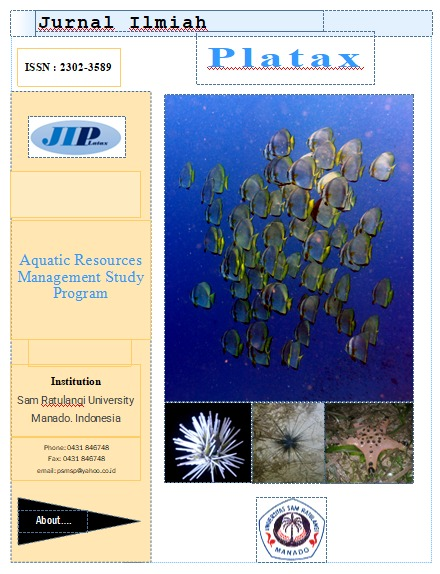A Preliminary Studies of Fish Richness in the Tondano River Estuary Manado Bay
DOI:
https://doi.org/10.35800/jip.v11i2.50025Keywords:
beach seine;, migrant;\, species;, resident;Abstract
The purpose of this study was to analyze the richness of fish species in the Tondano River estuary. Sampling was done for two months, in July and August 2022, new moon phase, during the low tide at 13.00-16.00 pm. Sampling used a 20-m beach seine with a cod-end part of 0.2-cm mesh and wings of 2-m height and 1.5-cm mesh. The beach seine was operated 10 times starting from the lowest tide at 13.00 pm to the tide condition at 16.00 pm. As a whole, 736 individuals were caught, consisting of 24 species and 17 families, 14 migrant species, and 10 resident species The number of fish varied from 1 to 445 individuals, in which Terapon jarbua (445 ind) was the most abundant, followed by Neovespicula depressifrons (70 ind). The dominant index (C) was 0.38 and the diversity index (H) was 1.65. The resident species were 120 individuals varying from 2 to 70 ind., and the most abundant was Neovespicula depressifrons (70 ind.). The dominant index (C) was 0.37 and the diversity index was 1.47.
References
Arceo-Carranza,D., and M.E.Vega-Cendejas, 2009. Spatial and temporal characterization of fish assemblages in a tropical coastal system influenced by freshwater inputs: Northwestern Yucatan peninsula. Int. J. Trop. Biol. Vol. 57:89-103.
Barletta, M.,and S.J.M.Blaber, 2007. Comparison of fish assemblages and guilds in tropical habitats of the Embley (Indo-West Pacific ) and Caetê (Western Atlantic) estuaries. Bulletin of Marine Science, 80(3): 647–680.
Barletta,M., A.Barletta-Bergan, U.Saint-Paul, and G.Hubold, 2005. The role of salinity in structuring the fish assemblages in a tropical estuary. Journal of Fish Biology 66 (1):45-72.
Bataragoa, N.E., 2014. The Dynamic of Tidal Migratory Fish Community in the Estuary of Poigar River, North Sulawesi, With Emphasis on the Biological of Trevally, Caranx sexfasciatus Quoy and Gaimard, 1825. (Disertation) Barawijaya University Indonesia. 193 p.
Bataragoa, N.E., D.Setyohadi, A. Sartimbul and D. Arfiati, 2014. Biodiversity of fish utilizing intertidal estuary of poigar river during high-tide North Coast of North Celebes, Indonesia. J. Bio. & Env. Sci.: 4 (4):370-378.
Bataragoa, N.E., D.Arfiati, D.Setyohadi, and A.Sartimbul, 2012. A Preliminary Study on Fish Assemblages in Estuaries at Northen Peninsula of Sulawesi Island: With Emphasis on the Presence of Marine Migrant Jacks Carax sexfasciatus and Caranx papuensis (Carangidae). International Seminar of Indonesian Icthyological Society, Makassar Indonesia June 12, 2012.
Bataragoa,N.E., A.D.Kambey dan A.P. Harahap, 1997. River Fish in Minahasa Minahasa Peninsula. Sam Ratulangi University Research Report 55 p.
Bataragoa,N.E and A. D. Kambey, 2021. Species of Fish in rivers in the Northern Peninsula of Sulawesi Island. Jurnal Ilmiah Platax 9(1): 66-88
Elliott, M., A.K Whitfield, I.C Potter, S.J.M.Blaber, D.P.Cyrus, F.G.Nordlie, and T.D Harrison. 2007. The guild approach to categorizing estuarine fish assemblages: a global review. Journal Compilation Fish and Fisheries 8: 241–268.
Fischer, W., and P.J.P.Whitehead, 1974. FAO Species Identification Sheets For Fishery Purposes, Eastern Indian Ocean (fishing area 53) and Western Central Pacific (fishing area 71) Vol. I-IV. Food and Agriculture Organization of the United Nations. Roma.
Genisa, A.S., 1990. Fauna ikan di muara Sungai Pemali Brebes Jawa Tengah. Makalah disampaikan pada Seminar Ilmiah Nasional, Lustrum ke VII Fakultas Biologi Universitas Gajah Mada 20-21 September 1990.
Göltenboth, F., K.H.Timotius, P.P.Milan, and J.Margraf, 2006. Ecology of Insular Southeast Asia the Indonesian Archipelago. Elsevier Radarweg 29, PO Box 211, 1000 AE Amsterdam, The Netherlands.
Johnston, R., M.Sheaves and B.Molony, 2007. Are distributions of fishes in tropical estuaries influenced by turbidity over small spatial scales?. Journal of Fish Biology 71: 657–671.
Kottelat, M., A.J. Whitten, S.N. Kartikasari and S. Wirjoatmodjo, 1993. Freshwater fishes of Western Indonesia and Sulawesi. Periplus Editions, Hong Kong. 221 p
Masuda, H., K. Amaoka, C. Araga, T. Uyeno and T. Yoshino , 1984. The fishes of the Japanese Archipelago. Vol. 1. Tokai University Press, Tokyo, Japan. 437 p. (text)
Salindeho, I.R.N, R.C. Kepel, N.E. Bataragoa, and R.A.Tumbol. 2020. First report on the seasonal and spatial variation of the species composition of amphidromous goby fry schools in Tondano and Poigar-river Estuaries, North Sulawesi, Indonesia. AACL Bioflux 15 (1): 44-53
Sasanti RS and HY Sugeha. 2008. Recruitment Pattern of Juvenile Fishes into Pami River Estuary (West Papua, Indonesia). Marine Research in Indonesia, 33(2): 145-153
Spellerberg, I.F and P.J Fedor, 2003. A tribute to Claude Shannon (1916–2001) and a plea for more rigorous use of species richness, species diversity, and the ‘Shannon–Wiener’Index. Global Ecology and Biogeography 12(3): 177-179.
Whitfield, A.K., 2010. A century of fish research in South African estuaries. African Journal of Aquatic Science, 35:3, 211-225.
Downloads
Published
How to Cite
License
Copyright (c) 2023 Nego E. Bataragoa, Silvester Benny Pratasik, Fransine B. Manginsela, Dulce Maria Dauhan, Indra Tombi

This work is licensed under a Creative Commons Attribution-NonCommercial 4.0 International License.
COPYRIGHT
Authors who publish with this journal agree to the following terms:
Authors hold their copyright and grant this journal the privilege of first publication, with the work simultaneously licensed under a Creative Commons Attribution License that permits others to impart the work with an acknowledgment of the work's origin and initial publication by this journal.
Authors can enter into separate or additional contractual arrangements for the non-exclusive distribution of the journal's published version of the work (for example, post it to an institutional repository or publish it in a book), with an acknowledgment of its underlying publication in this journal.
Authors are permitted and encouraged to post their work online (for example, in institutional repositories or on their website) as it can lead to productive exchanges, as well as earlier and greater citation of the published work (See The Effect of Open Access).




















